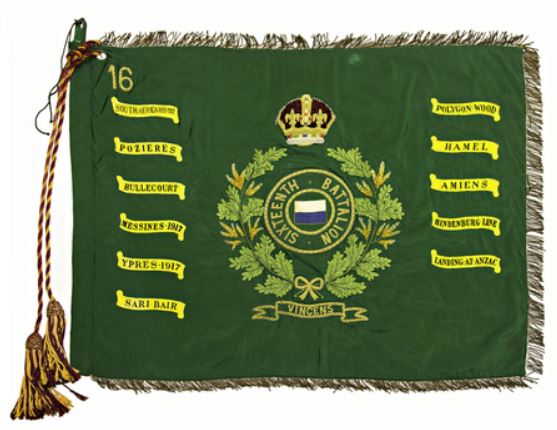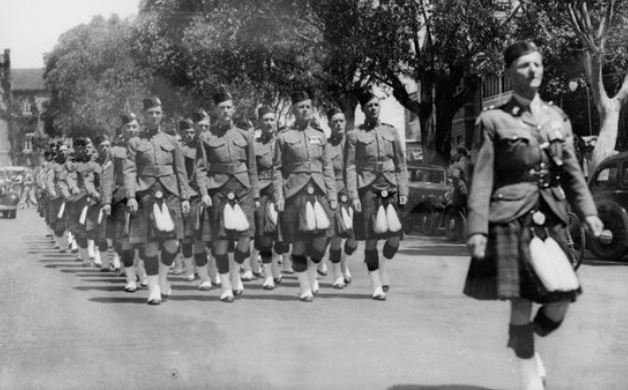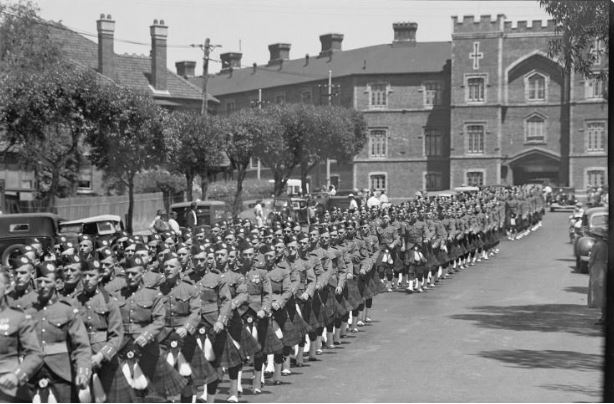Difference between revisions of "16th Australian Infantry Battalion (Cameron Highlanders Regiment)"
From Our Contribution
(→Individual Honours) |
|||
| Line 7: | Line 7: | ||
| image = [[File:16_Battalion.jpg]] | | image = [[File:16_Battalion.jpg]] | ||
| caption = | | caption = | ||
| − | | image2 = | + | | image2 = [[File:16th_Cameron_Highlanders.jpg]] |
| − | | caption2 = | + | | caption2 = c 1937 |
| + | | image3 = [[File:16th_Cameron_Highlanders_1.jpg]] | ||
| + | | caption3 = Marching east on St Georges Terrace - note Barracks in rear. | ||
}} | }} | ||
| Line 14: | Line 16: | ||
==Brief History== | ==Brief History== | ||
| − | The 16th Battalion was originally raised in September 1914. It landed at Gallipoli the following year, and also saw service in France. The battalion was disbanded at the end of the war. | + | The 16th Battalion was originally raised in September 1914. It landed at Gallipoli the following year, and also saw service in France. The battalion was disbanded at the end of the war. Following the end of WW 1, Australia's defence was conducted by the part time soldiers of the Citizens Military Force (Militia). It was re-raised as a Citizen Military Force unit, and amalgamated with the 11th Battalion in 1930. Organised to mimic the 1st AIF in structure and name, in 1936 the 16th Battalion became the Cameron Highlanders of Western Australia. Together with the 11th and 28th Battalions it formed the 13th Brigade, a part of the 4th Division and during WW 2 it was mobilised for war service , and gazetted as an AIF battalion. During the early war years, it formed part of the garrison of Western Australia, before moving north to Darwin in 1943. |
| − | |||
| − | |||
Revision as of 00:53, 28 December 2020
 | |
 c 1937 | |
 Marching east on St Georges Terrace - note Barracks in rear. | |
Contents
[hide]Brief History
The 16th Battalion was originally raised in September 1914. It landed at Gallipoli the following year, and also saw service in France. The battalion was disbanded at the end of the war. Following the end of WW 1, Australia's defence was conducted by the part time soldiers of the Citizens Military Force (Militia). It was re-raised as a Citizen Military Force unit, and amalgamated with the 11th Battalion in 1930. Organised to mimic the 1st AIF in structure and name, in 1936 the 16th Battalion became the Cameron Highlanders of Western Australia. Together with the 11th and 28th Battalions it formed the 13th Brigade, a part of the 4th Division and during WW 2 it was mobilised for war service , and gazetted as an AIF battalion. During the early war years, it formed part of the garrison of Western Australia, before moving north to Darwin in 1943.
In late 1944, the 13th Brigade, of which it was part, was reassigned to the 5th Division and subsequently took part in the New Britain Campaign from November 1944 until the end of the war. The campaign was limited to containing the larger Japanese force, and the battalion's involvement was focused primarily around undertaking long range patrols. Only limited combat occurred before the end of the war, and the battalion's casualties were light, amounting to 10 killed and 14 wounded. After undertaking garrison duties at Rabaul, the battalion returned to Australia in early 1946 and was disbanded in February at Puckapunyal.
Battalion personnel
- † Leslie John (Jock) Powell DFC April 1938- November 1940 to RAAF
- Colin Lindsay Ottaway DFC 16 Dec 1940 - 17 Jan 1942 - to RAAF
- † Vernon Harold Minchin 6 Mar 1941 - 30 Oct 1942 - to RAAF
- Douglas George Edgar Alexander
- Herbert Andrew Thomas Alexander
- Robert Neil Anderson
- Noel Aubrey Brown 19 Sep 1941 - 17 Apr 1944
- Keith James Buckingham
- Maxwell John Buckingham
- Raymond Ernest Buckingham to RAAF
- Herbert Bunney 16 Feb 1940 - 8 Feb 1946
- Herbert Patrick Carter 18 Feb 1944 - 28 May 1945
- Richard Noel Craigie 6 Nar 1941 - 9 Dec 1943
- Roy William Davey 24 Jul 1942 - ????
- Harold Frank Davy 6 Mar 1941 - 6 Jan 1944
- Norman Lenard (Bob) Dunnell 6 Mar - 27 Nov 1941
- Cecil Sydney Fahey
- Jack Raymond Fuller
- Alfred James Gregory ??? - 27 Nov 1945
- Thomas Robert Halliday 6 Mar 1941 - 15 Jan 1942
- John Milton Hand
- Maxwell Robert Joyner 21 Nov 1940 - Oct 1942
- Mervyn Maitland 24 Sep 1941 - 22 Jan 1942
- Charles Kenneth Neilson
- Thomas Donald Neilson 6 Mar 1941 - 23 Jul 1943
- Gordon Charles Page
8 Leslie John (Jock) Powell DFC - to RAAF
Battle Honours
- Waitavolo
Individual Honours
1 x Mentioned in Despatches
Notes